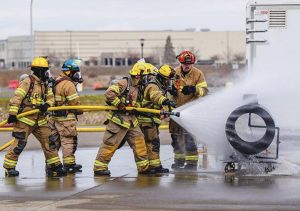 Primary search training is a critical part of a firefighter’s skill set, ensuring that when lives are at risk during a fire, the search for victims is swift, efficient, and systematic. The training must mimic real-world conditions as closely as possible to help firefighters gain proficiency in working under stressful, dangerous, and low-visibility environments. Below are detailed steps and tips to effectively conduct primary search training, whether in an acquired structure or at the station.
Primary search training is a critical part of a firefighter’s skill set, ensuring that when lives are at risk during a fire, the search for victims is swift, efficient, and systematic. The training must mimic real-world conditions as closely as possible to help firefighters gain proficiency in working under stressful, dangerous, and low-visibility environments. Below are detailed steps and tips to effectively conduct primary search training, whether in an acquired structure or at the station.
- Start with Donning Turnout Gear
Before jumping into the search training, begin with donning turnout gear. This not only ensures that firefighters are fully protected, but it also serves as a reminder to get comfortable with their equipment. Firefighters should be proficient in putting on their gear quickly and correctly without having to visually check each step (e.g., snaps, zippers, flaps). Emphasizing the importance of this ensures that they are always ready to respond with the necessary PPE.
Key points include:
Gear familiarity: Firefighters must be familiar with where they store critical items like gloves and protective hoods.
Standard procedures: Develop a standard way to don gear, ensuring consistency across the team.
Condition of gear: Regularly inspect the gear for cleanliness and wear to avoid gear malfunction during real operations.
- Understand the Local Structure Layouts
Search proficiency is not just about technical skills but also about understanding the type of structures common in your district. Firefighters should be familiar with layouts of homes, apartments, or multi-family dwellings in their jurisdiction. Incorporating this into training by simulating common structural layouts improves the team’s ability to navigate and conduct effective searches in real scenarios. Discuss unique configurations that may present challenges (e.g., older buildings with multiple renovations) and ensure firefighters understand the risks of disorientation.
- Hands-On Training Options
While conducting primary search training in an acquired structure is ideal, you can still provide valuable training at the fire station.
Using Acquired Structures
Realistic scenarios: Training in actual residential homes provides realistic layouts, enhancing the firefighter’s ability to conduct a search. Seek permission from owners of vacant properties in your area for these training exercises.
Using the Fire Station
Simulated props: If real structures aren’t available, simulate various rooms using furniture, tables, chairs, and pallets in an open space such as the apparatus bay. Recreate bedrooms, family rooms, and hallways to mimic a real house.
Basic configurations: Set up scenarios that include challenges such as confined spaces or closet searches, but keep it simple for primary search training.
- Organize Teams and Tools
Divide participants into two-person teams, the minimum number for a safe and efficient search. Teams should be equipped with:
Hand tools: Such as halligans or axes.
Thermal Imaging Cameras (TICs): If applicable, allow firefighters to practice using TICs during the search for an enhanced learning experience.
- Integrate Radio Communication Practice
Radio communication is a critical skill for search operations. Train firefighters to operate radios under real-world conditions, including:
- Operating with gloves.
- Changing channels while navigating in zero visibility.
- Communicating effectively while using SCBA.
The practice should start with notifying the incident commander that they are entering to conduct a primary search. This step adds realism to the exercise and builds proficiency in critical communication skills.
- Entry and Movement Techniques
Train firefighters on the fundamentals of making entry:
Door check: Before entry, firefighters should check the door for heat to ensure they are not about to enter a compromised space.
Sound the floor: Once inside, they should use tools to sound the floor to assess the structural integrity and avoid potential collapse.
Search Patterns
Adopt a standard search pattern for all training exercises to ensure consistency across the department. This eliminates confusion during real emergencies and ensures all team members follow the same process when entering a structure.
Sweeping motions: As firefighters search, they should sweep the area using their hands or tools to identify beds, furniture, or potential victimsStay oriented: The search crew should maintain constant communication with one another, discussing where they are and what they are finding.
- Train for Controlled, Swift Searches
A primary search must balance thoroughness and speed. Ensure that teams work at a controlled pace, systematically covering rooms without rushing, which could result in missing victims.
Room checklist: Have teams mentally (or physically, if necessary) check off the rooms they’ve searched to ensure full coverage.
Communication on exit: Once the search is complete, the crew should report back to the IC, giving an “all clear” if no victims are found.
- Search and Suppression Tactics
In scenarios with limited resources, firefighters may need to perform both search and fire suppression simultaneously. Training for this type of multitasking involves:
Serch with a hose line: Teams of two can move the line quickly through a structure, searching for victims while also suppressing fire.
Balance priorities: Teach firefighters how to make quick decisions on whether to prioritize fire suppression or search based on immediate conditions (e.g., location of fire versus likely location of victims).
Ventilation: After knocking down the fire, initiate ventilation to improve conditions for further search operations.
- Make Search Training Routine
Search training should be repeated often to ensure firefighters develop muscle memory. The more often these skills are practiced, the more confident and efficient the teams will be during an actual fire.
 Firefighter search training is an essential element of preparedness, and the ability to conduct a primary search must become second nature for all team members. Incorporating hands-on training, consistent communication practice, and balancing search with fire suppression will ensure that firefighters are well-prepared to face any search-and-rescue operation safely and effectively. This requires ongoing training, situational awareness, and a clear understanding of both the risks and techniques involved in executing a primary search.
Firefighter search training is an essential element of preparedness, and the ability to conduct a primary search must become second nature for all team members. Incorporating hands-on training, consistent communication practice, and balancing search with fire suppression will ensure that firefighters are well-prepared to face any search-and-rescue operation safely and effectively. This requires ongoing training, situational awareness, and a clear understanding of both the risks and techniques involved in executing a primary search.























































